They escaped a world of fast fashion to teach L.A. how to give old clothes new life
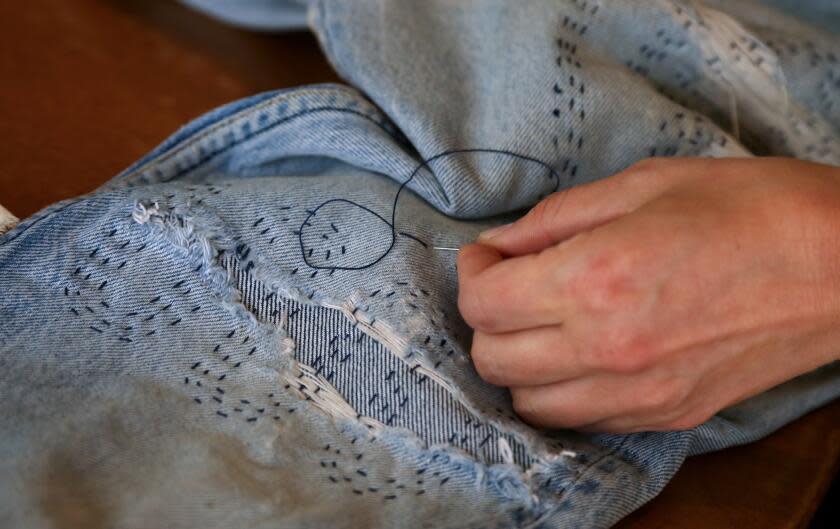
It’s a rainy Wednesday evening at low-lit, moody Arts District hangout Tea at Shiloh, where a dozen students including myself perch on round white floor cushions, sipping carob cardamom tea and peering uncertainly at piles of denim on the low tables before us. Each of us has brought a ripped or damaged item of clothing from our closet, hoping to extend its life and keep it from the Goodwill bin.
We’re not here to hide our healing handiwork as talented seamstresses would, making tiny, nearly invisible stitches secreted under seams or camouflaged by the denim’s color. Instead, Kim Krempien and Betsy Flores, clothing designers and founders of creative reuse collective Other Lives Studio, urge us in this workshop to make wildly colorful visible stitches that are also part of a larger creative design. To inspire us in our big, bold designs, Flores and Krempien have placed a mood board at the front of the room, displaying the styles of some of their embroidery influences: Maison Margiela, Jil Sander, Sashi.Co, and Yohji Yamamoto, to start. In one inspirational photo, a large multicolored butterfly spans the entire seat of a vintage pair of Miss Sixty jeans, while in another, shiny silver flowers splay across a Dries van Noten jacket.
Read more: 11 places in L.A. to get your creativity flowing. Pottery! Neon bending! Bookbinding!
“You think you have to take clothes to the tailor, who makes stitches perfectly invisible, but mending can be very visible, and that’s our preference,” Krempien says.
Using electric blue and cherry red yarn, we seam together our denim rips over gentle chatter, creating decorative designs of clouds and triangles in the teahouse. At my table, one participant is pulling his very first stitch ever under Krempien’s guidance, while a fashion student is creating swirls on a denim jacket. Flores comes around to gas us up, complimenting our progress. Stitching cloud outlines on the back pocket of my black jeans makes me feel like a little kid doodling, and I lose myself in the process as two hours race by. Our evening activity is quiet, alcohol-free and soothing — a vibe I wouldn’t have expected from a gathering of mostly twenty- and thirty-somethings, but which a neighbor informs me is the norm at Shiloh. We leave with needles and thread to continue our projects at home.
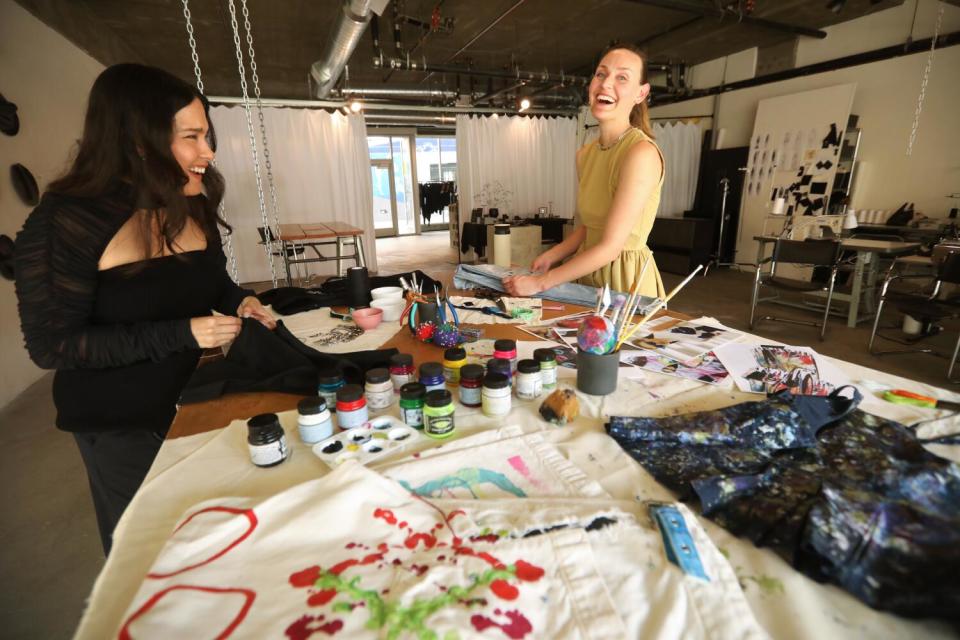
Flores and Krempien are part of an upcycling and creative reuse movement sweeping Los Angeles, one that eschews humble Stitch-and-Bitch sewing classes and crunchy crocheted hats for an eclectic, contemporary fusion of high fashion, Japanese mending techniques, do-it-yourself punk sensibility and environmental sustainability. As at creative reuse shops like Suay Sew Shop in DTLA and Remainders Creative Reuse in Pasadena, the goal isn’t making a knit scarf for your dad so much as it is ripping up his old dress shirt and transforming it into a multicolored kimono, all with minimal effort.
Other Lives calls itself a “redesign atelier,” which highlights its intentions to elevate old clothes to look as striking and experimental as couture, at a minimal cost to both the wearer and the environment. Other Lives isn’t asking fashionistas to leave behind the outrageous world of high-end style; their workshops list influences of specific designers’ seasons: for the keyhole tee workshop, it’s Rick Owens Spring 2018, and for the marble dye workshop, it’s Dries Van Noten Spring/Summer 2021. “We want to toe the line between being accessible and inspirational,” Krempien says.
Read more: Letting go of the pressure to be perfect? That's a craft
The founders come to the creative reuse culture from high-fashion backgrounds themselves, working with Nordstrom, Revolve and Vince. They met in 2016 at an industry event and eventually began an impassioned dialogue about sustainable fashion while working together to design and develop capsules for Nordstrom’s Private Label Collections. Frustrated with fast fashion’s toxic pollution of the Global South and Los Angeles’ massive apparel industry, they vowed to start Other Lives, which would breathe fresh life into castoff clothing by facilitating revelatory workshops including metalwork and fabric painting.
“Fashion is an unsustainable process because it’s producing too much to be a viable avenue,” Krempien says. “With original design manufacturing, you produce 30 to 40 or more samples per season, doing four collections a year, and it really adds up and becomes a space issue and a moral issue. I couldn’t bear to keep thinking about creating this many unused garments, knowing that even when these samples go down the avenue of clothing donation, it’s a broken system, where most of it is either landfilled or shipped to another country.”
As they prepared to launch Other Lives’ website in the spring of 2020, the pandemic canceled their first in-person workshop. They pivoted to online workshops, teaching exclusively through Zoom for two years and beginning in-person workshops in 2022.
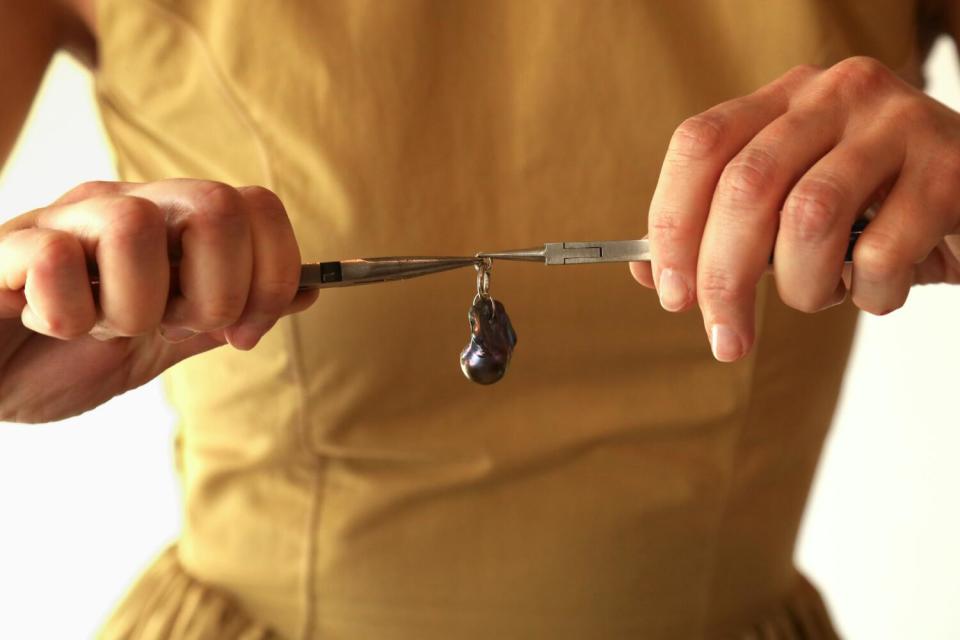
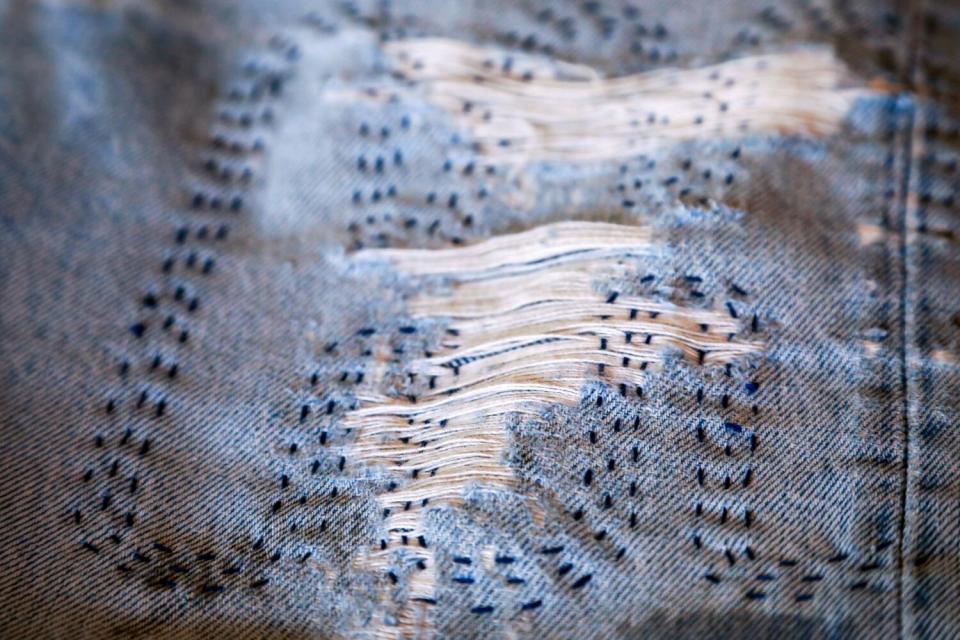
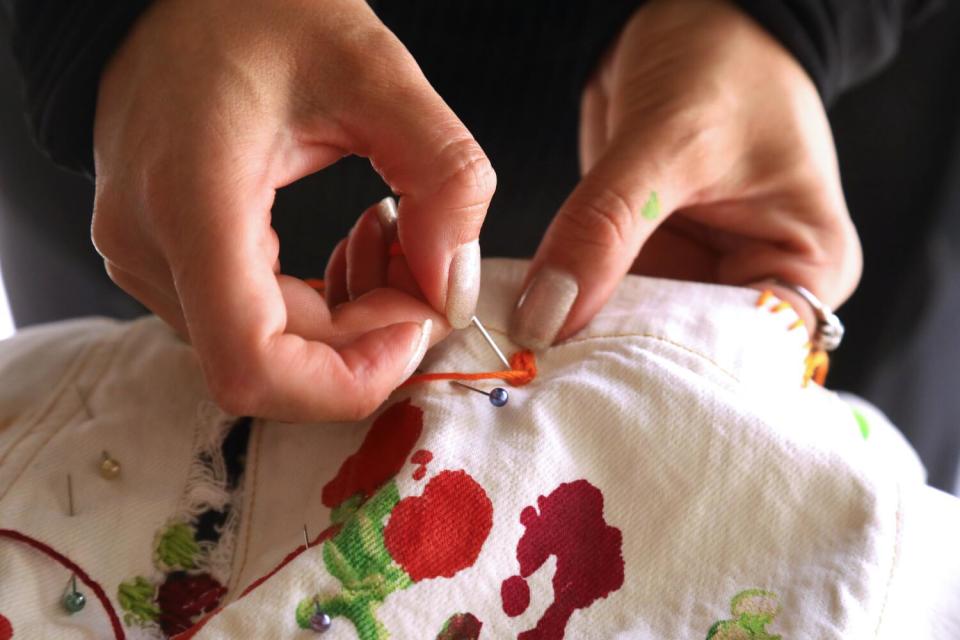
Flores says their skills, from strategic lacing design to jewelry collage, are learnable for anyone, even someone who’s never sewn a stitch or fixed a necklace. “When you think something is not feasible or beyond your skill set, it almost feels like you shouldn’t even be trying,” Flores says. “Our workshops help take the pressure off, because you’re in a community of people learning, and people are less intimidated and more open to trying and attempting not just what they’ve learned, but really anything. It’s really an empowering opportunity as far as creativity goes.”
Other Lives gives a starting point to uncertain upcyclers not only in the form of its workshops at Venia Studio, but also through its blog, TikTok, Instagram and YouTube videos. Last year, students in the jewelry collage workshop deconstructed and recombined old metal pieces, charms, pearls, stone beads, crystals, rings and chains into mixed media jewelry, while students in the lace workshop enlarged garments that no longer fit by creating lacing with grommets, loops and laces.
Most fashion items are worn only seven to 10 times, which is making some consumers question not only their durability, but their versatility for wearing multiple times. Flores believes that part of the frustration is the lack of understanding of a garment, and how it can be creatively modified. She says that when a consumer sews or patches an item, they are less likely to dispose of it afterward. “When you give an article of clothing a second life by editing it, you’re creating a connection to the piece,” she says.
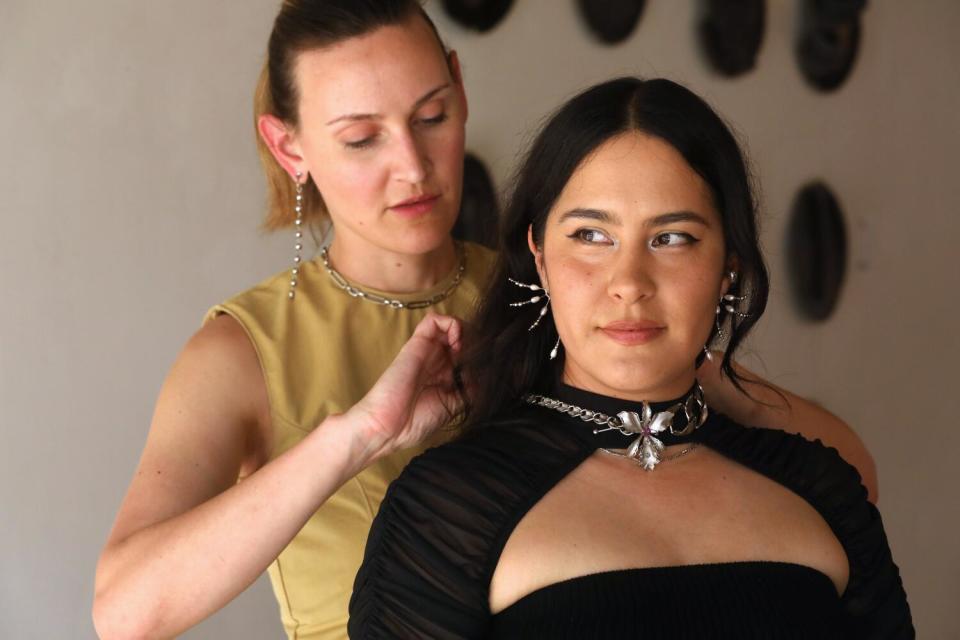
For Flores, there’s meaning and spirituality in the items we wear. Coming on the heels of the Marie Kondo phenomenon, which mainstreamed the Shintoist-influenced practice of thanking an item for its service, Other Lives’ name implies the power imbued in respecting a clothing item enough to revive it. Other Lives makes meaning out of old, cast-off clothes, drawing on the practices and philosophies of Japanese creative techniques like suminagashi dyeing, sachiko embroidery and kintsugi ceramics mending to see the redeeming spirit in an item, to repair the unrepairable. “When you go thrifting or go to a flea market, from the moment you pick something up, you can’t help but wonder what life it had,” the designer says. “I do believe things have energy, from whatever it meant to you and the memories and moments you created with it. Everything has potential, and that goes for us humans, too.”
But empowering others to be creative and revamp their own clothing hasn’t been enough for the duo, environmentally speaking. Other Lives also repurposes the development waste, including soles and foam, from its partnership companies, including Deckers Brands, which owns Ugg, Hoka and Teva, among other labels.
Read more: The designer who turned her pain into a colorful crochet brand (spotted on Kendrick Lamar)
In the future, Other Lives hopes to expand its educational offerings from one or two workshops a season to an array of diverse seasonal programming, using donations it’s received. The collective also hopes to create DIY upcycling kits to sell, which upcyclers at home would use while following Other Lives YouTube tutorials. A creative reuse festival or retreat might even be in the cards someday, Flores says.
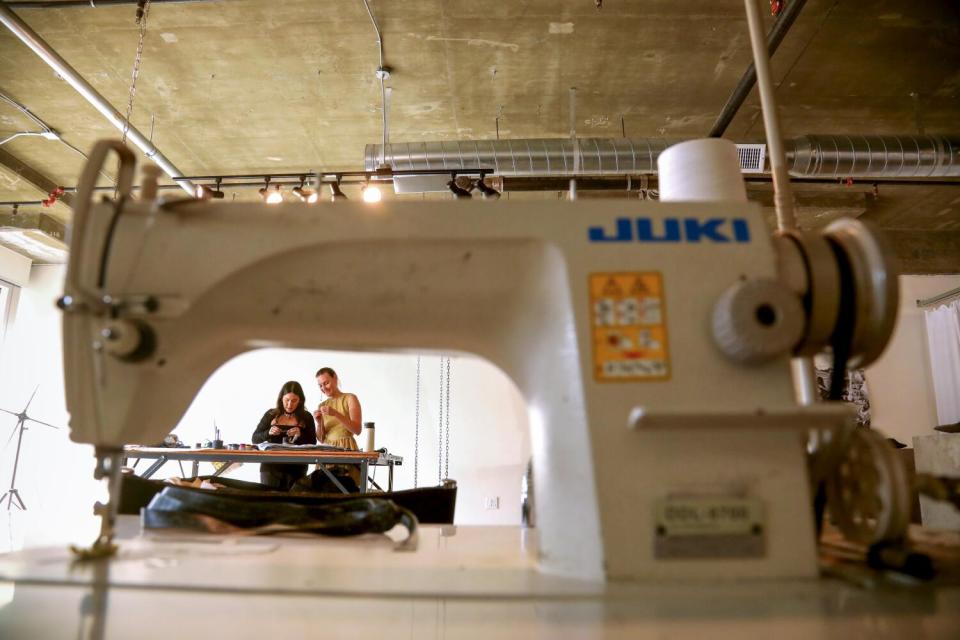
In the meantime, Flores and Krempien urge those who can’t attend a workshop to log onto social media to get inspired. “Search ‘DIY project,’ ‘upcycling’ or ‘creative reuse’ on Pinterest, TikTok, Instagram,” Krempien says. “It’s not just us, which is really amazing, because when we started we didn’t know any other upcyclers. You’ll find lots of projects to get inspired.”
What you may end up with is an item unlike anything else in the world — a unique piece of artwork — which is what's so much fun about upcycling. “Who doesn’t want to feel unique and feel like a piece is personal to me?" Flores says. "It can also be a conversation starter, because when people see it, [they] will want to try it themselves.”
This story originally appeared in Los Angeles Times.


